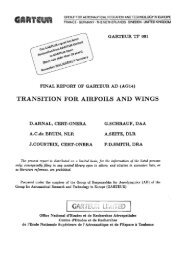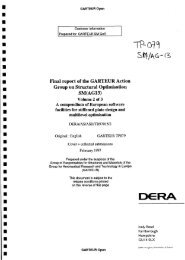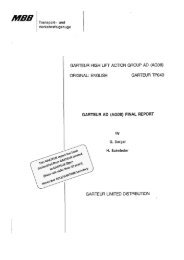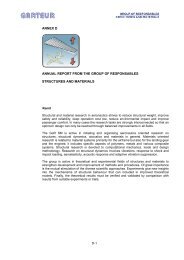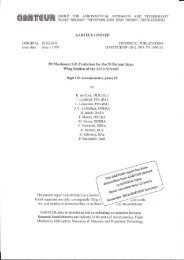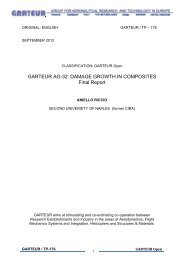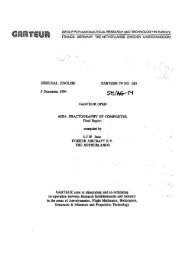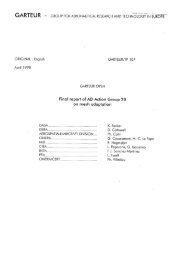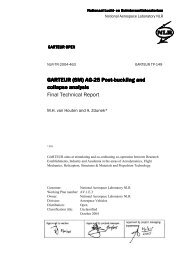Cadmium Substitution - garteur
Cadmium Substitution - garteur
Cadmium Substitution - garteur
You also want an ePaper? Increase the reach of your titles
YUMPU automatically turns print PDFs into web optimized ePapers that Google loves.
GARTEUR LIMITED<br />
5 Environmental survey<br />
Surveys were made to establish the effect of the coatings being evaluated on workers<br />
involved in the manufacture and maintenance of aerospace components and the impact<br />
of the coatings on the environment.<br />
5.1 Effect on workers<br />
The survey considered the potential risk to workers from the handling of aerospace<br />
coated parts during the assembly and maintenance of aircraft. It also examined the risks<br />
to workers in metal finishing shops with regard to the application of the coatings. Tables<br />
13 and 14 summarise the findings of the survey.<br />
5.2 Effect on outside environment<br />
A survey of each of the coatings was made to establish the effects of the coatings on the<br />
environmental. Four aspects were considered:-<br />
• costs of disposal of waste materials<br />
• remnants of corroded coatings<br />
• waste water flow<br />
• air pollution<br />
Results of the survey are summarised in tables 15 to 18.<br />
Table 15 indicates that the cost of disposing of waste materials produced by the<br />
alternative coating processes are likely to be much lower than that incurred with<br />
cadmium electroplating. In the case of the two physical vapour deposition processes,<br />
IVD aluminium and UBMS aluminium - magnesium, accurate costs are not available.<br />
Several of the processes involve the use of post plating passivation treatments<br />
containing chromates and there will be some costs concerned with the treatment of rinse<br />
waters etc.<br />
One problem encountered with cadmium plated parts is the handling of components<br />
which are corroded. <strong>Cadmium</strong> corrosion products are highly toxic and may be taken into<br />
the body if suitable health and safety precautions are not taken. The assessment given<br />
in table 16 suggests that the health risk from corrosion products on the alternative<br />
coatings is minimal.<br />
Potential problems associated with the treatment and disposal of waste water from the<br />
various coating processes are summarised in table 17. The main conclusion is that the<br />
alternatives do not present major problems. Waste water from cadmium electroplating<br />
facilities requires considerable treatment to reduce the cadmium ion concentration to a<br />
level that meets environmental controls. Some problems may be encountered with the<br />
other coatings, which employ chromate based passivation treatments to improve<br />
corrosion resistance and paint adhesion. This includes the electrodeposited zinc alloy<br />
coatings and the PVD and electrodeposited aluminium coatings. Rinse solutions<br />
containing hexavalent chromium ions will need to be treated before they may be<br />
discharged into rivers etc.<br />
The possible air pollution risks arising from chemicals employed in the various coating<br />
processes are outlined in table 5.6. Some slight hazards result from the use of butanol in<br />
the production of Magni-coat and the use of toluene in the aluminium electrodeposition<br />
process. The risk from cadmium compounds used in plating are well documented if<br />
allowed to become airborne.<br />
GARTEUR SM/AG17 TP128 Page 15




